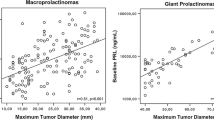Abstract
In women, prolactinomas (mainly microprolactinomas) are commonly diagnosed between 20–40-year old. In postmenopausal women, prolactinomas are rarely encountered and usually do not present with hyperprolactinemia-related symptoms as these are dependent on intact ovarian function. Therefore, the true incidence of prolactin (PRL)-secreting adenomas in postmenopausal woman is unknown. Our study objective was to characterize these rare and unique pituitary tumors. A retrospective study including a consecutive group of postmenopausal women followed and treated at 3 Endocrine academic clinics. Baseline clinical characteristics (PRL and gonadotropins levels, other pituitary hormones, adenoma size and invasiveness, visual fields) and response to treatment are reported. The cohort included 14 postmenopausal women with prolactinomas (mean age at diagnosis, 63.6 ± 7.1 years; range, 54–75 years). Mean adenoma size at presentation was 25.6 ± 12.4 mm (range, 8–50 mm). Six out of the 14 women had significant visual fields damage. Mean baseline PRL level was 1,783 ng/ml, and median PRL was 827 ng/ml (range, 85–6,732 ng/ml). Medical treatment with cabergoline was given to twelve of the patients. Cabergoline normalized/near-normalized PRL in eleven women; one woman was dopamine agonist-resistant. Five of the six subjects with visual disturbances normalized or improved their vision, and a pre-treatment diplopia in another patient disappeared. Two large pituitary tumors disappeared on MRI following long-term dopamine agonist therapy. All other treated prolactinomas, except the resistant adenoma, shrank following medical treatment. Prolactinomas are rarely diagnosed in postmenopausal women. These women usually harbor large and invasive macroadenomas, secreting high PRL levels, and usually respond to dopamine agonist treatment.

Similar content being viewed by others
References
A. Colao, A.D. Sarno, P. Cappabianca, F. Briganti, R. Pivonello, C.D. Somma, A. Faggiano, B. Biondi, G. Lombardi, Gender differences in the prevalence, clinical features and response to cabergoline in hyperprolactinemia. Eur. J. Endocrinol. 148, 325–331 (2003)
M.P. Gillman, M.E. Molitch, G. Lombardi, A. Colao, Advances in the treatment of prolactinomas. Endocr. Rev. 27, 485–534 (2006)
R.D. Calle-Rodrigue, C. Giannini, B.W. Scheithauer, R.V. Lloyd, P.C. Wollan, K.T. Kovacs, L. Stefaneanu, A.B. Ebright, C.F. Abboud, D.H. Davis, Prolactinomas in male and female patients: a comparative clinicopathologic study. Mayo Clin. Proc. 73, 1046–1052 (1998)
E. Delgrange, J. Trouillas, D. Maiter, J. Donckier, J. Tourniaire, Sex-related difference in the growth of prolactinomas: a clinical and proliferation marker study. J. Clin. Endocrinol. Metab. 82, 2102–2107 (1997)
T. Mindermann, C.B. Wilson, Age-related and gender-related occurrence of pituitary adenomas. Clin. Endocrinol. (Oxf.) 41, 359–364 (1994)
H.L. Fideleff, H.R. Boquete, M.G. Suárez, M. Azaretzky, Prolactinoma in children and adolescents. Horm. Res. 72, 197–205 (2009)
S. Christin-Maître, B. Delemer, P. Touraine, J. Young, Prolactinoma and estrogens: pregnancy, contraception and hormonal replacement therapy. Ann. Endocrinol. (Paris) 68, 106–112 (2007)
S. Abu-Fadil, G. DeVane, T.M. Siler, S.S. Yen, Effects of oral contraceptive steroids on pituitary prolactin secretion. Contraception 13, 79–85 (1976)
I. Shimon, C. Benbassat, M. Hadani, Effectiveness of long-term cabergoline treatment for giant prolactinomas: study of 12 men. Eur. J. Endocrinol. 156, 225–231 (2007)
A. Ciccarelli, E. Guerra, M. De Rosa, F. Milone, S. Zarrilli, G. Lombardi, A. Colao, PRL secreting adenomas in male patients. Pituitary 8, 39–42 (2005)
M. Berezin, I. Shimon, M. Hadani, Prolactinoma in 53 men: clinical characteristics and modes of treatment (male prolactinoma). J. Endocrinol. Invest. 18, 436–441 (1995)
L. Vroonen, M.L. Jaffrain-Rea, P. Petrossians, G. Tamagno, P. Chanson, L. Vilar, F. Borson-Chazot, L.A. Naves, T. Brue, B. Gatta, B. Delemer, E. Ciccarelli, P. Beck-Peccoz, P. Caron, A.F. Daly, A. Beckers, Prolactinomas resistant to standard doses of cabergoline: a multicenter study of 92 patients. Eur. J. Endocrinol. 167, 651–662 (2012)
E. Delgrange, G. Raverot, M. Bex, P. Burman, B. Decoudier, F. Devuyst, U. Feldt-Rasmussen, M. Andersen, D. Maiter, Giant prolactinomas in women. Eur. J. Endocrinol. 170, 31–38 (2014)
J.J. Pinzone, L. Katznelson, D.C. Danila, D.K. Pauler, C.S. Miller, A. Klibanski, Primary medical therapy of micro- and macroprolactinomas in men. J. Clin. Endocrinol. Metab. 85, 3053–3057 (2000)
A. Colao, G. Vitale, P. Cappabianca, F. Briganti, A. Ciccarelli, M. De Rosa, S. Zarrilli, G. Lombardi, Outcome of cabergoline treatment in men with prolactinoma: effect of a 24-month treatment on prolactin levels, tumor mass, recovery of pituitary function, and semen analysis. J. Clin. Endocrinol. Metab. 89, 1704–1711 (2004)
J. Webster, G. Piscitelli, A. Polli, C.I. Ferrari, I. Ismail, M.F. Scanlon, A comparison of cabergoline and bromocriptine in the treatment of hyperprolactinemic amenorrhea. Cabergoline comparative study group. N. Engl. J. Med. 331, 904–909 (1994)
R.S. Auriemma, L. Granieri, M. Galdiero, C. Simeoli, Y. Perone, P. Vitale, C. Pivonello, M. Negri, T. Mannarino, C. Giordano, M. Gasperi, A. Colao, R. Pivonello, Effect of cabergoline on metabolism in prolactinomas. Neuroendocrinology 98, 299–310 (2013)
A. Ciresi, M.C. Amato, V. Guarnotta, F. Lo Castro, C. Giordano, Higher doses of cabergoline further improve metabolic parameters in patients with prolactinoma regardless of the degree of reduction in prolactin levels. Clin. Endocrinol. (Oxf) 79, 845–852 (2013)
S.S. Inancli, A. Usluogullari, Y. Ustu, S. Caner, A.A. Tam, R. Ersoy, B. Cakir, Effect of cabergoline on insulin sensitivity, inflammation, and carotid intima media thickness in patients with prolactinoma. Endocrine 44, 193–199 (2013)
G. Mazziotti, T. Mancini, M. Mormando, E. De Menis, A. Bianchi, M. Doga, T. Porcelli, P.P. Vescovi, L. De Marinis, A. Giustina, High prevalence of radiological vertebral fractures in women with prolactin-secreting pituitary adenomas. Pituitary 14, 299–306 (2011)
Conflict of interest
The authors declare that they have no conflict of interest regarding the study reported.
Author information
Authors and Affiliations
Corresponding author
Rights and permissions
About this article
Cite this article
Shimon, I., Bronstein, M.D., Shapiro, J. et al. Women with prolactinomas presented at the postmenopausal period. Endocrine 47, 889–894 (2014). https://doi.org/10.1007/s12020-014-0259-1
Received:
Accepted:
Published:
Issue Date:
DOI: https://doi.org/10.1007/s12020-014-0259-1




